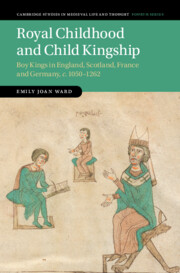Book contents
- Royal Childhood and Child Kingship
- Cambridge Studies in Medieval Life and Thought
- Royal Childhood and Child Kingship
- Copyright page
- Dedication
- Contents
- Figures
- Preface and Acknowledgements
- Abbreviations
- Genealogies
- Chapter 1 Royal Childhood and Child Kingship
- Part I Royal Childhood and Child Kingship: Models and History
- Part II Royal Childhood: Preparation for the Throne
- Part III Child Kingship: Guardianship and Royal Rule
- Bibliography
- Index
Chapter 1 - Royal Childhood and Child Kingship
An Introduction
Published online by Cambridge University Press: 04 August 2022
- Royal Childhood and Child Kingship
- Cambridge Studies in Medieval Life and Thought
- Royal Childhood and Child Kingship
- Copyright page
- Dedication
- Contents
- Figures
- Preface and Acknowledgements
- Abbreviations
- Genealogies
- Chapter 1 Royal Childhood and Child Kingship
- Part I Royal Childhood and Child Kingship: Models and History
- Part II Royal Childhood: Preparation for the Throne
- Part III Child Kingship: Guardianship and Royal Rule
- Bibliography
- Index
Summary
Medieval societies did not exclusively and inflexibly conceive kingship as the remit of a mature man, even if adult male rulers were more typical. This introduction shows the urgency and timeliness of looking beyond the ‘unspoken hegemony’ of adulthood to understand the intersections between childhood and kingship. Focusing first on the interconnectedness of representation and reality, the chapter highlights the necessity of uniting an emphasis on children’s lived experiences as political actors with an examination of cultural representations of ideas about childhood and rulership. The introduction then turns to consider three essential components which shape this study’s methodology: a comparative approach, a diachronic analysis and a holistic approach to the sources. This section argues for the importance of contextualising child kingship within a wider comparative framework which accounts for political, social, cultural and legal change. It also sketches the benefits of adopting a broad approach to the source material which incorporates chronicle, documentary, didactic, epistolary, legal and literary sources.
Keywords
- Type
- Chapter
- Information
- Royal Childhood and Child KingshipBoy Kings in England, Scotland, France and Germany, c. 1050–1262, pp. 1 - 30Publisher: Cambridge University PressPrint publication year: 2022

